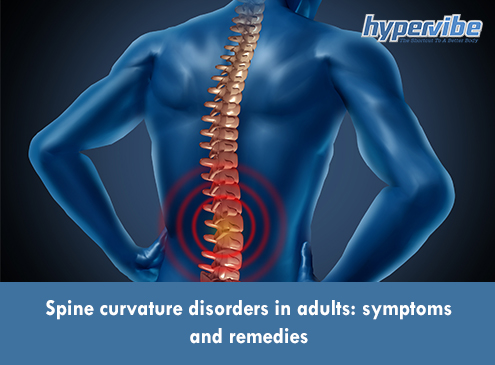
Adult spinal deformities are not an uncommon issue, studies reporting a prevalence of 2.5% to 25% in the general population, with numbers going as high as 68% in the population aged 60 years and above. In most cases, the deformities, which are defined as changes in the alignment of the spine, are not significant, and don’t cause disability. However, for some, the deformities are mild to severe and have a major impact on the quality of life.
Often, the most common spine deformities – scoliosis, kyphosis or lordosis – are diagnosed in patients who seek medical care because of leg pain or back pain that doesn’t go away. The deviation in the spinal column alignment is considered significant and treated as a medical condition when it exceeds 10 degrees (frontal view), or when the spine is visibly deformed from the side.
Some cases don’t cause symptoms other than mild back pain or stiffness, but in others numbing, shooting pain in the legs as a result of pinched nerves and cramping are also present. The strain on the muscles of the lower back and legs can also cause fatigue and reduced function.
If the curvature of the spine is close to the natural one, you may not see a noticeable change in posture, but if the spine is affected by scoliosis for example, then you may be able to see a very accentuated C or S shape and the shoulders and waist will appear uneven.
If one’s spine just looks deformed due to poor posture, but is not affected by pathological deviations, it can be corrected by simply standing up straight or adjusting the position if sitting. However, spinal deformities that are pathological can not be fixed by simply changing posture, they require medical intervention which can be anything from exercises for the core and back muscles, flexibility exercises, pain relievers, wearing a brace for pain relief and for correcting the deformity, or receiving surgical treatment for restoring the spine’s normal curvature.
The causes of scoliosis, lordosis and kyphosis vary from one person to another. Scoliosis can occur in any age group, and affects men and women alike.
The symptoms and severity depends on the age of onset, in some patients the only issues being discomfort and pain while standing or sitting, while in others scoliosis can lead to breathing difficulties, sitting imbalance and development issues. Pelvic and shoulder height imbalances, rib humps, leg and back pain, numbness and weakness, gait problems are also likely to occurs in more serious cases of scoliosis.
Depending on its onset, scoliosis can be classified into infantile, which affects children under 3 years old, juvenile, which occurs in patients between 3 and 10 years, adolescent, affecting teens of up to 17 years old, and adult degenerative scoliosis. Infantile scoliosis is usually associated with other neurodegenerative disorders like cerebral palsy, and is corrected through surgery sometimes, although in most cases no procedure is done until the spine grows completely.
In juvenile scoliosis, the deformities tend to be progressive, and braces are often recommended for preventing the worsening of symptoms and correcting the spine’s curvature.
Idiopathic scoliosis seems to be caused by genetic factors, and contrary to popular belief it is not the result of carrying a heavy backpack or maintaining poor posture. This form of scoliosis is defined by tilted and uneven shoulders, with one shoulder blade protruding more than the other, a hip higher than the other, an uneven waistline and also prominence of the ribs on one side.
This type of scoliosis may be treated differently depending on its severity; sometimes a brace is prescribed, along with physical exercises, and other times surgical intervention is needed. Same happens in adult degenerative scoliosis, which usually affects the lumbar spine and is more painful than the adolescent form. This type of scoliosis causes nerve compression and pain.
Besides scoliosis, kyphosis can also affect the spine; this deformity is seen when the back is rounded forward, and is more common in older women. Often it occurs as a result of osteoporosis, or because of the weakening of back muscles, but can also be seen in infants and teens if spine and bone malformations are present.
The mild cases may not cause too much symptoms, but the more serve one can be disfiguring. The fact that the spinal balance changes with kyphosis can cause increased stress on the lower body, and can lead to pain and neurologic loss of function. Posture and walk can be severely affected.
Besides the already mentioned causes, kyphosis can also be the result of disk degeneration which occurs with age, and can be caused by birth defects, certain forms of cancer or cancer treatments, and by Scheuermann’s disease. Treatment options include pain relievers and osteoporosis drugs, physical exercises and bracing, with or without surgical intervention.
As for lordosis, this deformity of the spine is defined as excessive inward curvature, and affects all age groups. The typical aspect is the swayback, with the buttocks more prominent, and an exaggerated posture. Pain and movement difficulties are sometimes present.
Lordosis can be caused by obesity, discitis and osteoporosis, or can appear in combination of kyphosis or spondylolisthesis. If the intervertebral disc space gets inflammed (discitis), or when the natural cervical curvature of the spine becomes exaggerated, or the bones become weaker and get deformed, lordosis can develop.
As with the other deformities of the adult spine, treatment may vary depending on causes, symptoms and severity. Sometimes surgery is needed, while other times physical therapy with specific exercises and bracing are enough.

Updated on: 08.09.2021 The lymphatic system is involved not only...

Stress can make you gain weight – we’ve heard this...

Various theories exist to answer this question. As you will...

Both rebounding and jumping on a trampoline are excellent ways...

The health benefits of using vibration plates to burn fat...